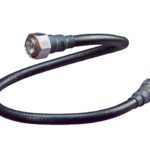RFID – Radio Frequency IDentification That Keeps You Well-Connected
By Alexander M. Schmoldt, Business Development—Europe, Murata Electronics Europe B.V.
October 9, 2012
What does a wireless identification system such as RFID have to do with cables and connectors? Recent developments in the world of RFID are creating new possibilities for cost savings as well as creating transparency and thus reliability of connections. RFID technology can transform a cable into a smart object that can provide information about itself at any time of its life cycle, anywhere in the world.
RFID
RFID is the abbreviation for Radio Frequency Identification. The name itself explains a lot about the technology. It is a means of identifying objects while utilizing electromagnetic and magnetic fields, but it is more than that. The tags that are attached to the objects they are identifying also have incorporated a memory in which data about the object can be stored and altered. An important aspect in the versatility and usefulness of this concept is that so-called “passive” RFID does not require a battery or any other power source on the side of the tag in order to function.

The illustration above shows the basic elements of an RFID system. The magnetic or electromagnetic field that is created by the antenna of the reader/writer (reader) powers the chip (IC – integrated circuit) at the heart and enables it to do all necessary operations. RFID is thus an energy harvesting technology. Although this power transmitted through the field of the reader is enough to enable the operations in the IC, it is not sufficient for an active transmission of the necessary data back to the reader. The principle utilized is similar to radar and officially called backscattering, which means the tag distorts the field created by the antenna of the reader in a defined way. This antenna and the front-end circuit of the reader need to be sensitive enough to detect these distortions.
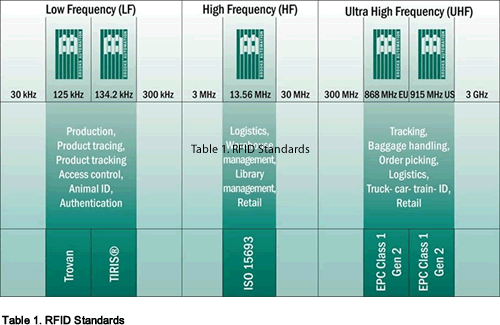
The details of this form of communication are defined in global standards. Table 1 (above) gives an overview of these standards and the achievable communication ranges. In this article, we will concentrate on UHF and HF RFID. Due to the shorter wavelengths, these technologies provide the best performance in terms of tag size and cost versus communication range, compared to LF solutions. Figure 2 (below) shows an example of one of the recent solutions in RFID: tag modules. This new concept in RFID modules enables two different possible uses: one is use of these modules with booster antennae, which is the traditional way. The other option allows these tag modules to utilize their own incorporated antenna function. Thus, they function as a complete tag. The minimal size of these modules limits the communication range, however. If necessary, they can couple to a larger booster antenna, in order to extend the communication range.

The size of these modules explains the compatibility of RFID to cables and connectors. Since the modules can withstand a molding process, they can be incorporated into cables and connectors. Once it is equipped with such an RFID module, a cable or connector will immediately become a smart object. That means aside from a unique ID, which reliably distinguishes it from any other cable or connector, it also carries information about itself in the user memory of the RFID tag. The user memory for the storage of data at the cable today ranges, depending on the type of IC used inside, from 512b up to 3.3kb. This is a different approach, which offers new possibilities compared to traditional solutions, which usually attach a tag with a strap or by other means to the cable, after it has been manufactured.
The possibility to embed the tag during the manufacturing process into the cable or connector enables a variety of cost reductions and creation of added values. This starts with the possibility of using the tag for process control purposes in the various production steps and extends to tracking in distribution and even beyond, to service in the field once the cable is installed. As the tag stays with the cable for its lifetime, it also can be used for any kind of necessary processes at the end of life (EOL) of a cable. This means that the exact date of EOL will become visible. The whole life cycle of a cable will become transparent to the manufacturer of the cable and any other stakeholder who has interest in this data.
As the tag also includes memory, important data will always be available at the installation site. Additionally, the memory is rewritable, so the date of last maintenance or the date of delivery can be stored in the cable. Data retention time is up to 50 years, which should be sufficient to make all necessary data available for recycling or any other process at EOL.
Let’s look at the differences of these two solutions.
Miniature UHF Solutions for Smart Connectivity
As visible in Figure 2, the UHF solution is clearly the smallest. Package sizes of 2 x 1.2mm or 3.2 x 1.6mm and a typical height of 0.55mm clearly make it the only choice for applications with extreme space restrictions. Furthermore, it provides extreme flexibility in the choice of its position on or in the object. It can be glued to the surface, placed in a cavity or embedded in plastic. Even though it is so small, a communication distance of over 7mm can be achieved.
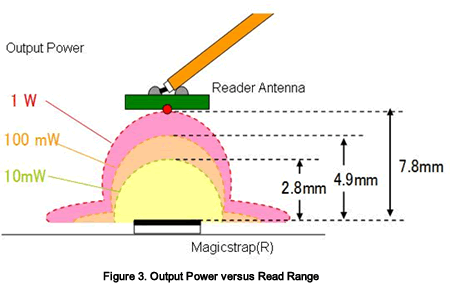
Figure 3 shows the achievable read range versus the necessary power of the reader. This scalability of the range by the reader power also shows that this UHF tag module is the ideal choice, in case cables or connectors located close to each other need to be reliably identified individually. A cable or a connector with such an embedded UHF tag will become a smart object. This information can also be altered and new information added. As a system, there are now two solutions possible.
The first scenario is the individual identification case. In that case, individual cables should be identified by an operator or a technician, for instance for maintenance purposes or at an installation process. Figure 4 below shows a portable reader, which can communicate with the miniature tag and has a Bluetooth interface. This means it can connect to a smartphone or a tablet on which a maintenance technician can process the data from the cable. Of course, he can also write data to the tag on the cable or connector, such as the actual maintenance or operation date, measurement results, or a port number. The system might give the operator handling instructions, created out of the combination of data at the cable and out of the system on his tablet or smartphone.
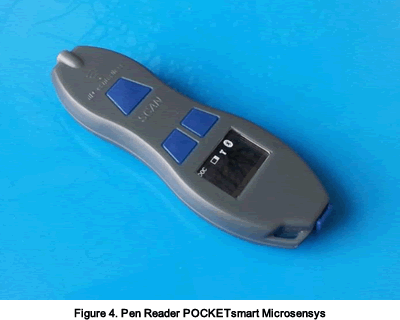
This video shows examples of the implementation and functionality embedded as well as on metal surfaces.
The other solution is automatic identification and data transmission. This could be used when it is necessary to retrieve information about the cables present in a router, server or similar, even when it is offline. Another scenario is automatic communication in production or other automated processes in the value chain. In this case a fixed reader, as shown in Figure 5 below, in combination with a movable small loop antenna or an antenna for fix installations, as shown in Figure 6, would be used. It is possible to connect multiple antennas to a fix reader. Usually they are available with 4 ports, which can be further multiplexed.

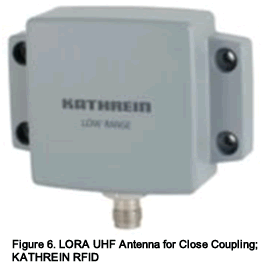
HF Solutions for Cables and Connectors
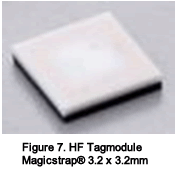 Another option for reliable identification of cables and connectors are miniature tags that include antenna, similar to the one shown in Figure 7 at the right. They operate in the HF RFID band, so they are a little bit bigger because the lower frequency requires a bigger antenna. An 8.5 x 8.5mm tag provides a read range of up to 40mm, while a 3.2 x 3.2 mm solution still provides a read range up to 15mm. The situation on the reader side is even a bit more comfortable than with the above UHF solutions. In addition to the small portable readers like the one shown above, just about any HF reader compliant to ISO 15693 or ISO 14443 can be utilized. That means, if a compliant IC is used in the module, an NFC-enabled mobile phone can communicate directly with the tag. As a result, if the tag were to be embedded in a cable or a connector, the only thing a service technician needs to check its identity and specification is his mobile phone. This also gives him the opportunity to connect to a database and retrieve further information about the connector. Of course the same is true when using readers with Bluetooth interface, such as those shown above.
Another option for reliable identification of cables and connectors are miniature tags that include antenna, similar to the one shown in Figure 7 at the right. They operate in the HF RFID band, so they are a little bit bigger because the lower frequency requires a bigger antenna. An 8.5 x 8.5mm tag provides a read range of up to 40mm, while a 3.2 x 3.2 mm solution still provides a read range up to 15mm. The situation on the reader side is even a bit more comfortable than with the above UHF solutions. In addition to the small portable readers like the one shown above, just about any HF reader compliant to ISO 15693 or ISO 14443 can be utilized. That means, if a compliant IC is used in the module, an NFC-enabled mobile phone can communicate directly with the tag. As a result, if the tag were to be embedded in a cable or a connector, the only thing a service technician needs to check its identity and specification is his mobile phone. This also gives him the opportunity to connect to a database and retrieve further information about the connector. Of course the same is true when using readers with Bluetooth interface, such as those shown above.
As HF RFID was introduced some years earlier than UHF, it is still more widespread in the market, and the number of HF readers is actually higher than that of the UHF readers. As a result, the cost for UHF reader ICs is still higher than that of HF reader ICs. But the increasing number of UHF applications in basically all industries will change this cost situation on the reader side. On the tag side, the cost of UHF tags is usually cheaper than that of HF tags. This is due to the need for bigger antennae to handle the bigger wavelength in the HF band. As a consequence, when developing a solution for cable identification, the number of required tags should always be considered. If a high number of cables are involved, certainly a UHF-based solution should be the more cost-effective solution, whereas the necessity for a high number of readers would make an HF solution the better choice, cost-wise.
These RFID solutions will provide a completely new approach to product lifecycle management and value creation in the cable industry. Cables and connectors can be easily turned into smart objects carrying relevant information, and the utilization of smart phones in combination with reader solutions that can connect to them enable further processing of cable data in a remote central database. More and more installations are equipped with RFID reader infrastructure that provide and automate information about the actual configuration, such as those from Cavea-ID. There are also complete solutions already available for cable identification in patch fields, such as the future patch system. Such systems offer a combination of increased security and maintenance cost reduction as infrastructure system operation becomes available, error-free and functional in real time.

